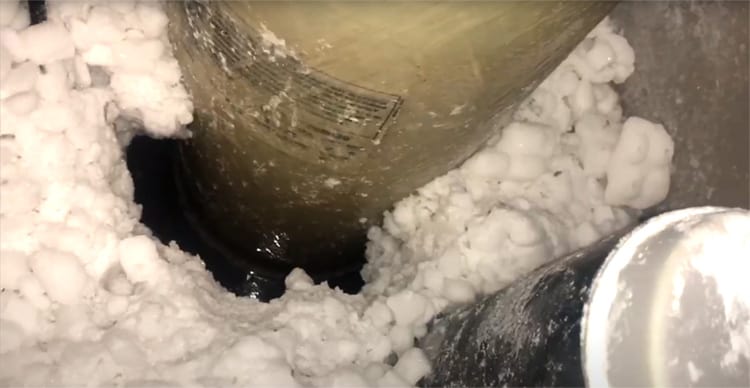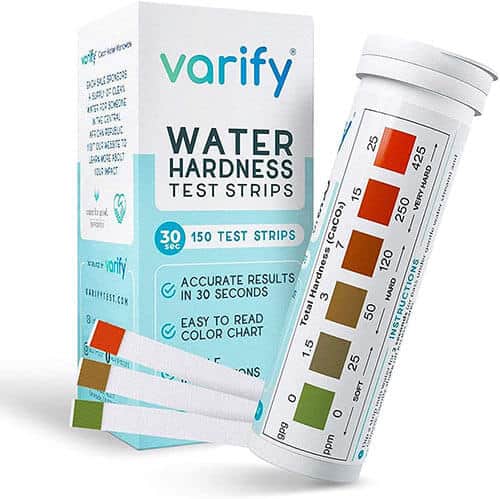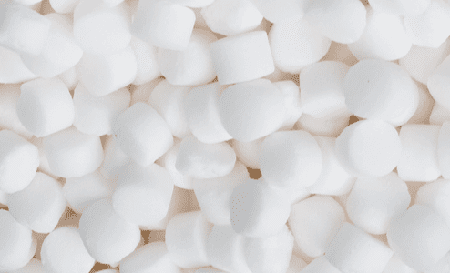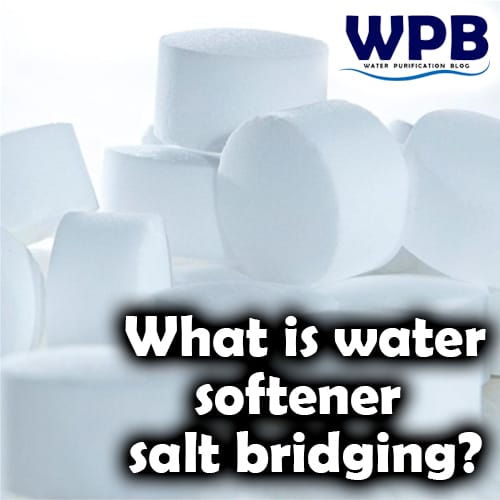Salt bridging is caused by the accumulation of salt on the surface of the salt tank, forming a hard layer that prevents the salt from dissolving, prevents creating a saturated brine solution and that is being drawn into the water softener resin tank during regeneration.
Table of Contents
What is s salt briding?
If you have a water softener installed in your home, then you want to read about this common problem that can occur with water softeners.
This solid layer of salt stays on top of the salt tank while all the salt beneath it is used. As the salt under this layer is used, there is not enough salt to make a saturated brine solution.
When you open the brine tank lid you see salt and it seems like everything is OK.
This will cause water softeners to have a regeneration cycle with less saturated brine solution, resulting in hard water at the softeners outlet.
What causes Salt Bridging?
A water softener salt crust layer can be caused by a variety of factors, including using too much salt, not using enough water, or using the wrong type of salt. The most common reason for a salt bridge is using too much salt.

Removing a salt bridge can be a difficult task, but it is important to do it in order to maintain the efficiency of your water softener. One way to remove a salt bridge is to use a stick or rod to break up the salt and stir it back into the water.
Salt bridges are a problem that can occur in water softener salt tanks, where a hard, surface crust of salt forms in the top section of the tank. This can give the appearance that the salt tank is full, while underneath the salt bridge, the tank is actually running low on salt, or empty.
How to recognize Salt Bridging?
One of the most obvious signs of a salt bridge is that the water softener isn’t working properly, even though there appears to be enough salt in the tank. Additionally, regeneration process isn’t working properly and the softeners operating capacity is much lower.
Another sign of salt bridging is a lack of softened water. Water softeners are programmed to regenerate when the resin beads inside the primary media tank are saturated with hardness minerals (calcium and magnesium). If the salt bridge is preventing this process from happening, there won’t be softened water at the softener’s outlet.
That is why it is important to check the hardness of your water after the softener. The fastest and most economical way to check water hardness are test strips.

Water Hardness Test Kit – Fast and Accurate Cost Effective Water Hardness Test Strips
Save time and get accurate water test results within seconds. Simply take one of the provided test strips and dip the test strip into the water. Compare the test strip colors with the large color chart on the bottle. This is your water hardness result.
No need to visit a store or wait for someone else to test the quality of your water.
Enjoy consistently accurate and reliable results whenever you need them.
Ideal for you water softener operation control.
In addition to these signs, it’s also possible that you’ll see a higher than normal salt reading in the brine tank. This can occur because the salt bridge is giving the appearance that the tank is full, while underneath the salt bridge, the brine tank is actually running low on salt, or empty.
How to prevent water softener salt bridging from occuring
Use the right salt – Use only manufacturer approved salt and make sure to use salt that has the right pellet size and does not contain any impurities. This can greatly reduce the potential for any problems, especially salt mushing.
Checking water softener brine tanks regularly – Keeping an eye on your salt tank to avoid any water softener salt bridge forming before it happens.
Maintain proper salt levels – Overfilling your brine tank with salt can lead to salt bridges. To prevent this, it is recommended to keep the brine tank half-full and use high-quality salt. Do not fill the tank more than 2/3 full and use high-quality salt, low-quality salt can contribute to bridging in your brine tank.
In addition, it is important to keep the brine tank clean. Regular cleaning of the tank can help to prevent salt bridges from forming.
How to solve salt bridging when it happens
It is a common issue in water softener systems, where a hard crust of salt forms on the surface of the water in the brine tank, preventing the salt from dissolving and regenerating the resin bed. If this happens, there are a few steps you can take to fix the issue and prevent it from happening again in the future.
Break it up
You can use a long-handled tool, such as a broom or mop, to tap the salt bridge with the handle until it breaks. This will allow the salt to fall to the bottom of the tank.
Scoop out the loose salt
Use a plastic container to scoop out the salt chunks from the top of the tank after breaking up the salt bridge.
Clean the salt tank
Drain the water from the brine tank using a garden hose, then opening the lid of the tank and use a putty knife or broom handle to pry away any chunks of salt that are stuck to the walls of the tank.
To learn more about how brine tank works, check out this article:
Avoid overfilling the brine tank
One of the most common causes of salt bridges is overfilling the brine tank. Make sure you don’t fill the tank more than 2/3 full to avoid this issue.
Use high-quality salt
Use high-quality salt to reduce the potential salt bridge occurs. Low-quality salt can contribute to the problem.

Keep an eye on the system regularly
Keep an eye on your system regularly to detect any signs before it becomes a bigger problem.
Conclusion
To prevent that salt bridge occurs in water softeners, it is important to regularly check and maintain the salt tank.
Steps to remove a salt bridge include using a long-handled tool, such as a broom or mop, to tap the salt bridge and break it up, scooping out the loose salt pellets, and lightly hammering at the edges of the salt crust.
To avoid salt bridge formation it in the first place, it is recommended to use high-quality water softener salt, and to check the salt tank water level, to make sure that the water is properly covering the salt.

Who am I?
I am working as a water treatment technical manager and I have more than 25 years of practical experience in water purification.
Water purification expert
After many years of experience in water purification, I want to share some of my knowledge and get people to know the real importance of water quality.
Water purification and water treatment are very complex themes, so it is important to explain them in an easy-to-read way.
On this blog, you will find many understandable, easy-to-read information about water purification.
I hope you enjoy it, find some useful information, and thank You for reading.
More info on my work and my expertise on water purification can be found on my LinkedIn profile.






